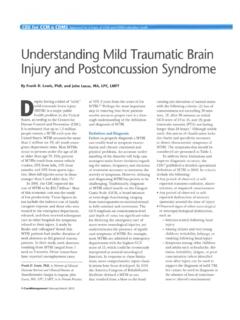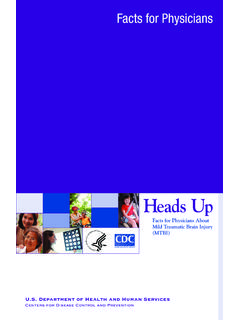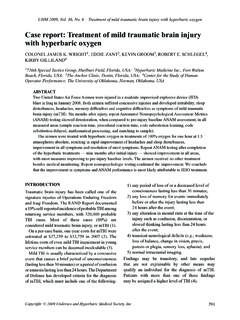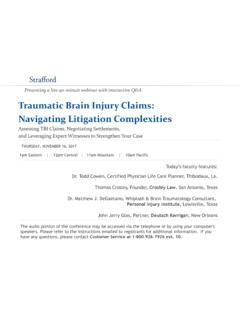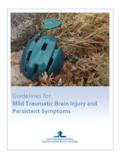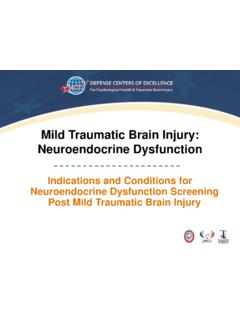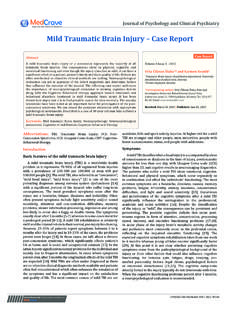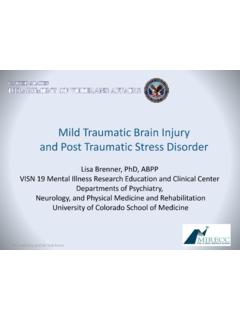Transcription of Mild traumatic brain injury - uems-neuroboard.org
1 EFNS GUIDELINES/CME ARTICLEMild traumatic brain injuryP. E. Vosa, Y. Alekseenkob, L. Battistinc, E. Ehlerd, F. Gerstenbrande, D. F. Muresanuf,A. Potapovg, C. A. Stepanh, P. Traubneri, L. Vecseijand K. von WildkaRadboud University Nijmegen Medical Centre, The Netherlands;bVitebsk Medical University, Vitebsk, Belarus;cIRCCS San CamilloHospital, Venice, Italy;dNeurologicka Klinika, Pradubice, Czech Republic;eLudwig Boltzmann Institute for Restorative Neurology andNeuromodulation, Vienna, Austria;fUniversity CFR Hospital, University of Medicine and Pharmacy Iuliu Hatieganu Cluj-Napoca,Romania;gInstitute of Neurosurgery, Russian Academy of Medical Sciences, Moscow, Russia;hNeurological Hospital Rosenh u gel, Vienna,Austria;iComenius University School of Medicine, Bratislava, Slovak Republic;jSzent-Gyo rgyi University Hospital, Szeged, Hungary; andkMedical Faculty Westphalien University Mu nster and International Neuroscience Institute INI, Hannover, GermanyKeywords:guideline, mild traumaticbrain injuryReceived 27 September 2011 Accepted 29 September 2011 traumatic brain injury (TBI) is one among the most frequent neurological all TBIs 90% are considered mild with an annual incidence of 100 300/100 complications of mild traumatic brain injury (MTBI) are infrequent(10%), requiring neurosurgical intervention in a minority of cases (1%), but poten-tially life threatening (case fatality rate ).
2 Hence, a true health managementproblem exists because of the need to exclude the small chance of a life-threateningcomplication in a large number of individual patients. The 2002 EFNS guideline usedthe best evidence approach based on the literature until 2001 to guide initial man-agement with respect to indications for computed tomography (CT), hospital admis-sion, observation and follow-up of MTBI patients. This updated EFNS guideline forinitial management in MTBI proposes a more selective strategy for CT when major[dangerous mechanism, Glasgow Coma Scale (GCS) < 15, 2 points deterioration onthe GCS, clinical signs of (basal) skull fracture, vomiting, anticoagulation therapy,post- traumatic seizure] or minor (age, loss of consciousness, persistent anterogradeamnesia, focal deficit, skull contusion, deterioration on the GCS) risk factors arepresent based on published decision rules with a high level of evidence.
3 In addition,clinical decision rules for CT now exist for children as well. Since 2001, recommen-dations, although with a lower level of evidence, have been published for clinicalobservation in hospitals to prevent and treat other potential threats to the patientincluding behavioural disturbances (amnesia, confusion and agitation) and brain injury (TBI) caused by sudden impactor acceleration deceleration trauma of the head isamong the most frequent neurological disorders [1].The acute phase of mild traumatic brain injury (MTBI)is characterized by a 10% risk for intracranial abnor-malities like contusion, subdural or epidural haematoma, brain swelling, subarachnoid haemorrhage, or pneu-mocephalus; a low risk (1%) of life-threatening intra-cranial haematoma that needs immediate neurosurgicaloperation both in adults and in children; and a very lowmortality of in adults and even lower in children[2,3].
4 Early management in MTBI deals with the rec-ognition and immediate medical treatment of physio-logical parameters that may worsen brain to the acute management of MTBI patients is therecognition of clinical signs and symptoms (risk factors)that increase the likelihood of intracranial haematomathat need neurosurgical operation. In 2002, the EFNS guideline on early management in MTBI was was defined as patients with head injury and aGlasgow Coma Scale (GCS) 13 15 (see Table 1 forclassification). This guideline was largely based on twoformal evidence-based clinical decision rules [4,5]. Inthe 2002 EFNS guideline, risk factors were defined asthose that are associated with intracranial abnormali-ties including life-threatening haematoma, which re-sulted in a set of rules for diagnostic imaging,observation and follow-up of : P. E. Vos, Radboud University Nijmegen MedicalCentre, Department of Neurology, Hp 935, Reinier Postlaan4, 9101, 6500 HB, Nijmegen, The Netherlands (tel.)
5 : +31243613396;fax: +31243541122; e-mail: by N. E. Gilhus, M. P. Barnes and M. Brainin 2011 Blackwell Publishing Ltd. ISBN: 978-1-405-18533-2 This is a Continuing Medical Education article, and can be found withcorresponding questions on the Internet at forcorrectly answering the questions will be issued by the EFNS. 2012 The Author(s)European Journal of Neurology 2012 EFNS191 EuropeanJournalofNeurology2012,19:191 198 the appearance of the EFNS guideline new datahave been published. Results of an independent Dutchmulticentre study on 3181 patients with MTBI dem-onstrated that the EFNS guideline has 100% sensitivityfor the detection of intracranial abnormalities afterMTBI [6]. Despite this convincing result from the pa-tient safety perspective, it was also concluded that thespecificity of the EFNS guideline is low and that thenumber of patients needed to be scanned to detectabnormalities is very limitations form an important reason to up-date and refine the EFNS guideline; and there have alsobeen reports that caution against the liberal use ofcomputed tomography (CT) because of an increase inlifetime cancer mortality risks attributable to radiationfrom CT [7].
6 Second, healthcare costs form a concern inMTBI. A restrictive use of CT compared to the currentguideline has been propagated. Selecting patients withMTBI for CT, ordering a CT less frequently, may becost-effective as long as the sensitivity of such proce-dures for the identification of patients who requireneurosurgery remains this version, based on new publications since 2001,we present updated guidelines for early management inMTBI with respect to the indication for CT andearly management (admission, clinical observation andfollow-up).Search strategyA systematic search of the English literature in theMEDLINE, EMBASE, Cochrane database (2001 2009) using the key words minor head injury , mild headinjury, mild traumatic brain injury , traumatic braininjury, guidelines and management. Additional articleswere identified from the bibliographies of the articlesretrieved, and from textbooks.
7 Articles were included ifthey contained data on classification system used ( GCS 13 15) and outcome data (CT abnor-malities, need for neurosurgical intervention, mortality)or management. Articles judged to be of historical valueand existing (new) guidelines were also included andreviewed for useful data. Where appropriate, a classi-fication of evidence level was given for interventions,diagnostic tests and grades of recommendation formanagement according to the neurological manage-ment guidelines of the EFNS [8]. Where there was alack of evidence but consensus was clear we have statedour opinion as Good Practice Points (GPP).Clinical decision rules for CTAdultsThe 2002 version of the EFNS guideline, which weighedheavily on two prospective Class I/II studies, offered adecision rule for use of CT to demonstrate the need forneurosurgical intervention or clinically important braininjury after MTBI [4,5,9].
8 It was subsequently demon-strated that the EFNS guideline compared to otherexisting guidelines has a high sensitivity for the identi-fication of patients with clinical relevant traumaticfindings at CT [6,10]. In addition, the EFNS guidelineconfirmed that in patients with MTBI the use of CT canbe safely limited to those who have certain clinicalfindings. The generalizability and reliability of existingguidelines and prediction rules is in general lower thanthose described in the original studies as was demon-strated in an independent sample of 1101 patientsevaluating 11 existing guidelines [10]. For an overviewof the risk factors used in existing guidelines rules andstudies from which they were derived, see Table 2. Thesensitivity of the original studies forming the basis forthe guidelines after external validation amounts to 85 100% for neurosurgical intervention and 85 96% forclinical important findings [10,11].
9 ConclusionVarious prediction rules that employ different riskfactors have high sensitivity and low specificity forclinically relevant intracranial abnormalities and theneed for neurosurgical operation (Evidence Level I).Table 1 Classification of traumatic brain injury and indication forimmediate head CTClassificationCharacteristicsIndicatio n forimmediatehead CTaMildHospital admissionGCS = 13 15 Loss of consciousness if present30 min or lessCategory1 GCS = 15 NoNo risk factors or only 1 minorrisk factor present (CHIP rule)Head injury , no TBI2 GCS = 15 YesWith risk factors: 1 majorrisk factor(s) or 2 minor riskfactors (CHIP rule)3 GCS = 13 14 YesModerateGCS = 9 12 YesSevereGCS 8 YesCriticalGCS = 3 4, with loss ofpupillary reactions and absentor decerebrate motor reactionsYesaMajor and minor risk factors for indication of immediate head CT inMTBI are shown in Table , Glasgow Coma Scale; TBI, traumatic brain injury ; CHIP, CT inhead injury E.
10 Voset al. 2012 The Author(s)European Journal of Neurology 2012 EFNSE uropeanJournalofNeurology19, 191 198 RecommendationProtocols for initial management in MTBI should in-clude a decision scheme or prediction rule algorithm forthe use of CT after MTBI (Grade A recommendation).ChildrenA quarter of all patients presenting to emergencydepartments are children. Until recently no formal pre-diction rule existed for the selection of children with headTable 2 Overview of prediction rules/guidelines for the detection of intracranial lesions and need for neurosurgical operation after MTBI in adultsRisk factorEFNS 2002 NOCCCHRCHIPNICENEXUS IIGCS = 13 15guidelineLOCGCS = 15n= 909 LOC orPTA GCS =13 15n= 3121 GCS = 13 14 GCS = 15 +risk factorn= 3181 GCS = 13 15guidelineBlunt headtraumaHistoryAge++ (>60 year) + (>65 year)+ (>60 year)or minor(40 60 year)+ (>65 year,if LOC)>65 Loss of consciousness+InclusionInclusionMinor)He adache++))Vomiting+++ (>2)++ (>1)+Post- traumatic seizureDizziness++Excluded++Pre-traumati c seizure)))))Anticoagulation therapy+)Excluded++ if LOC+ExaminationGCS score < 15+Excluded+ (at 2 hpost injury )++ (2 h postinjury)
